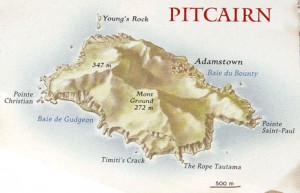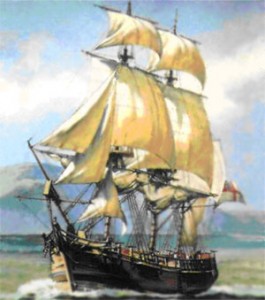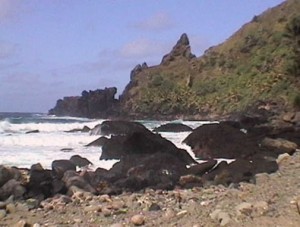Pitcairn Island is located at 25°05’S-130°05’W on the southeastern extension of the Duke of Gloucester-Mururoa-Gambier-Pitcairn volcanic alignment.
The Island of Pitcairn was discovered the 2nd. of July 1767 by captain Carteret on board the British vessel HMS Swallow. The name Pitcairn was given after the midshipman name that sighted the island first from the HMS Swallow. No landing party was sent at shore. Because of error in reporting the exact position on the navigation chart at the time, the Island stayed unknown and unfunded for 18 years after its discovery. Even today the island is isolated from normal sailing shipt’s route, which could be a blessing for the inhabitant. Only four scheduled supply ships per year will transit to bring mail and other suppies from the rest of the World. The island at that time was inhabitant but stone axes, remains of carved stone pillars, resembling those of Easter Island and skeletons with pearl mussels were found later on. The island made up by steep slopes of basaltic lava and dykes standing at 430 m high above the seafloor. It is 3.5 km long and about 2.5 km large located at about 2000 km from Tahiti, 3000 km from Easter Island and 5500 km from New Zealand.
A volcanic island
The island itself is in half moon shape open to the northeast by a volcanic crater of 3 km in diameter. The filled crater has a plateau shape with luxuriant tropical vegetation. The apparent age of the surface lavas from Pitcairn Island is between 0.45 and about 1 million year (Duncan et al., 1974; Woodhead and McCulloch, 1989; Devey et al., 2002). The last explosive eruption, which took place about six hundred thousand years ago cover the island of ash and basaltic lavas, which extended down to the ocean. The base of the Island is at 3800 m depth and mostly under water. Because of its volcanic nature the soil is fertile and the climate moderate all year around.
This volcanic Island become the refuge of the mutineers of the HMS Bounty on the 23rd of January 1790
until it was again found in 1808 by captain Mathew Folger on board the US vessel TOPAZ. The Island was inhabitant by only one man, John Adams (also called Alexander Smith) all the others were dead from the story told by the survivor. The Island entered in the legend in 1790 when Fletcher Christian the second in charge of the Bounty rebelled against Captain William Bligh in 1789 near the island of Tofoa in the vicinities of Fiji. Two third of the crew and officers rebel and 18 stay with Bligh. However it is only with 8 English sailors and officers Fletcher Christian with 6 Polynesian men and 12 Polynesian women went to settled on Pitcairn, the others had perished in Tubai Island during fighting with each other or find by the British and hang. However, before finding the Island of Pitcairn he took them several months, about two months, in finding an appropriate place to hide. In they journey they stopped in Tahiti and persuade other Polynesians man and women to follow them on board the Bounty. They were thirty-seven people. After finding the Island they burned the Bounty and settled down to communal life. The Island because of its morphology, steep vertical scarps of 200 m high and only one small rocky beach called the Bounty Bay is the only access by boat.
It is constantly under few meters high swells make the landing hazardous for any navigator. This was the ideal place for not getting unwelcome visitors.
By the 1800 all the men were dead and only John Adams stayed alive and took care of the youths and the 10 women left. In 1887 the islanders become Seven Day Adventist as religion. In 1823 sixty-six people were on the Island. The peak of the population was in 1936 when more than 200 persons leave on the island.
Roger













